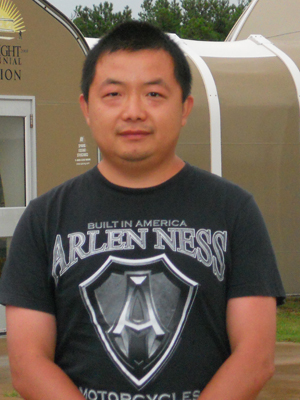
个人基本情况
石晓龙,2004年毕业于华中科技大学控制科学与工程系,获工学博士学位。2004年至2005年在华中科技大学生命科学院博士后流动站从事博士后研究,出站后留校任教。现任华中科技大学365体育教授、博士生导师。
石晓龙教授是湖北省运筹学会秘书长,中国电子学会生物计算与生物信息处理专业委员会秘书长,中国电子学会高级会员,美国化学会会员。长期以来一直从事生物计算与DNA纳米技术相关学术研究。2005年8月,担任首届国际智能计算大会 (ICIC2005),DNA计算分会主席。2009年9月至2011年4月,美国杜克大学计算机系Thomas LaBean教授实验室合作研究。2013年5月至6月,美国北卡莱罗纳州立大学DNA纳米技术实验室合作研究。
主要研究方向
人工智能,生物计算,DNA纳米技术
项目及成果
主持完成国家自然科学基金面上项目两项、青年一项
主持完成国家科技部863项目“大数分解DNA计算机模型研究”一项
研究成果获湖北省自然科学一等奖、教育部自然科学一等奖
代表论文
1.Shi X, Wu X, Song T, et al. Construction of DNA nanotubes with controllable diameters and patterns using hierarchical DNA sub-tiles[J]. Nanoscale, 2016, 8(31): 14785-14792.
2.Shi X, Chen C, Li X, et al. Size-controllable DNA nanoribbons assembled from three types of reusable brick single-strand DNA tiles[J]. Soft Matter, 2015, 11(43): 8484-8492.
3.Shi X, Lu W, Wang Z, et al. Programmable DNA tile self-assembly using a hierarchical sub-tile strategy[J]. Nanotechnology, 2014, 25(7): 075602.
4.Shi X, Wang Z, Deng C, et al. A novel bio-sensor based on DNA strand displacement[J]. PloS one, 2014, 9(10): e108856.
5.Wang Y, Ma X, Cui G. Logical Computation Using Algorithmic Self-Assembly of DNA Sub-Tile[J]. Journal of Computational and Theoretical Nanoscience, 2016, 13(6): 3959-3963.
6.Wang Y, Ma X, Li M, et al. Analogical China Map Constructed by Single-Stranded DNA Tiles Assembly[J]. Journal of Computational and Theoretical Nanoscience, 2016, 13(6): 3865-3870.
7.Wang Y, Tian G, Hou H, et al. Simple logic computation based on the DNA strand displacement[J]. Journal of Computational and Theoretical Nanoscience, 2014, 11(9): 1975-1982.
8.Wang Y, Zhao T, Shi X, et al. Controllable Deoxyribonucleic Acids Sub-Tile Self-Assembly by Deoxyribonucleic Acids Strand Displacement[J]. Journal of Computational and Theoretical Nanoscience, 2015, 12(10): 3774-3780.
9.Chen Z, Zhang P, Wu T, et al. A Novel Computational Approach to Predict Activity of Nuclear Export Signals[J]. Journal of Computational and Theoretical Nanoscience, 2015, 12(12): 6016-6019.
10.Chen Z, Zhao Y, Wang Z, et al. A Novel Method for the Construction of Evolutionary Tree Based on Expectation Maximization Algorithm[J]. Journal of Computational and Theoretical Nanoscience, 2016, 13(6): 3799-3803.
11.Chen Z, Song T, Huang Y, et al. Solving Vertex Cover Problem Using DNA Tile Assembly Model[J]. Journal of Applied Mathematics, 2013, 2013.
12.Chen Z, Qiang X, Zhang K. Molecular Model for Information Addressing and Transporting Based on DNA Nanotechnology[M]//Bio-Inspired Computing-Theories and Applications. Springer Berlin Heidelberg, 2014: 29-34.
13.Song T, Shi X, Xu J. Reversible spiking neural P systems[J]. Frontiers of Computer Science, 2013, 7(3): 350-358.
14.Shi X, Li X, Zhang Z, et al. Improve capability of DNA automaton: DNA automaton with three internal states and tape head move in two directions[C]// International Conference on Advances in Intelligent Computing. Springer-Verlag, 2005:71-79.
15.Shi X, Pan L, Jin X. General DNA automaton model with r/w tape[C]// International Conference on Computational Intelligence and Bioinformatics. Springer-Verlag, 2006:258-266.
16.Shao Z, Xu X, Shi X, et al. Some three-color Ramsey numbers, R(P 4, P 5, C k ) and R(P 4, P 6, C k )[J]. European Journal of Combinatorics, 2009, 30(2):396–403.